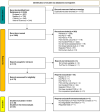A meta-analysis identifies factors predicting the future development of freezing of gait in Parkinson's disease
- PMID: 38049430
- PMCID: PMC10696025
- DOI: 10.1038/s41531-023-00600-2
A meta-analysis identifies factors predicting the future development of freezing of gait in Parkinson's disease
Abstract
Freezing of gait (FOG) is a debilitating problem that is common among many, but not all, people with Parkinson's disease (PD). Numerous attempts have been made at treating FOG to reduce its negative impact on fall risk, functional independence, and health-related quality of life. However, optimal treatment remains elusive. Observational studies have recently investigated factors that differ among patients with PD who later develop FOG, compared to those who do not. With prediction and prevention in mind, we conducted a systematic review and meta-analysis of publications through 31.12.2022 to identify risk factors. Studies were included if they used a cohort design, included patients with PD without FOG at baseline, data on possible FOG predictors were measured at baseline, and incident FOG was assessed at follow-up. 1068 original papers were identified, 38 met a-priori criteria, and 35 studies were included in the meta-analysis (n = 8973; mean follow-up: 4.1 ± 2.7 years). Factors significantly associated with a risk of incident FOG included: higher age at onset of PD, greater severity of motor symptoms, depression, anxiety, poorer cognitive status, and use of levodopa and COMT inhibitors. Most results were robust in four subgroup analyses. These findings indicate that changes associated with FOG incidence can be detected in a subset of patients with PD, sometimes as long as 12 years before FOG manifests, supporting the possibility of predicting FOG incidence. Intriguingly, some of these factors may be modifiable, suggesting that steps can be taken to lower the risk and possibly even prevent the future development of FOG.
© 2023. The Author(s).
Conflict of interest statement
T.H., Y.B., S.S. and M.B. have no conflicts of interest. N.G. has received funding from The Michael J Fox Foundation, The National Parkinson Foundation, The European Union and The Israel Science Foundation as well as from Biogen and Ionis, The Sieratzki Family Foundation, and The Aufzien Academic Center in Tel-Aviv University and consulting fees from Sionara, NeuroDerm, and Pharma2B. He has participated on a Data Safety Monitoring Board or Advisory Board of Pharma2B and NeuroDerm and has stock or stock options with GaitBetter LTD. J.M.H. has received grant funding from the US National Institutes of Health, the Israel Ministry of Health, the Michael J Fox Foundation for Parkinson’s Research and the National Multiple Sclerosis Society. He also is supported in part by the Mobilize-D project that has received funding from the Innovative Medicines Initiative 2 Joint Undertaking (JU) under grant agreement No. 820820. This JU receives support from the European Union’s Horizon 2020 research and innovation program and the European Federation of Pharmaceutical Industries and Associations (EFPIA). Content in this publication reflects the authors’ view and neither IMI nor the European Union, EFPIA, or any Associated Partners are responsible for any use that may be made of the information contained herein. He is also a consultant for F. Hoffman-La Roche Ltd, via Tel Aviv Sourasky Medical Center, and has stock or stock options with GaitBetter LTD. He is also on an advisory board of the Michael J Fox Foundation for Parkinson’s Research (no fee), participated on the task force for global guidelines on falls in older adults, on the Movement Disorders Society Task Force on Technology, on Stanford’s Restore Center advisory board, and on the Scientific Advisory Board of the Tel Aviv University Health Longevity Research Center.
Figures




References
Publication types
LinkOut - more resources
Full Text Sources
Miscellaneous

